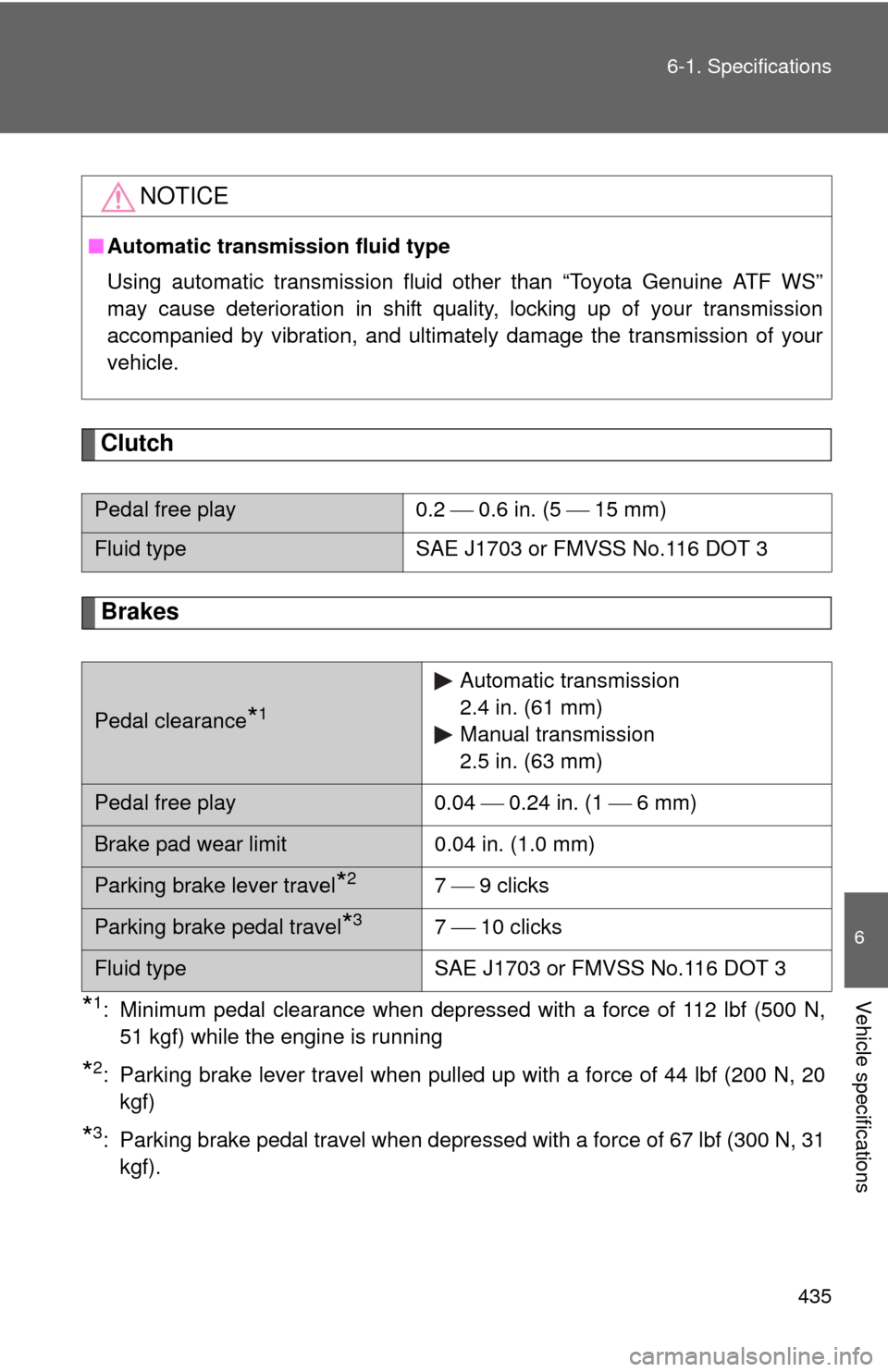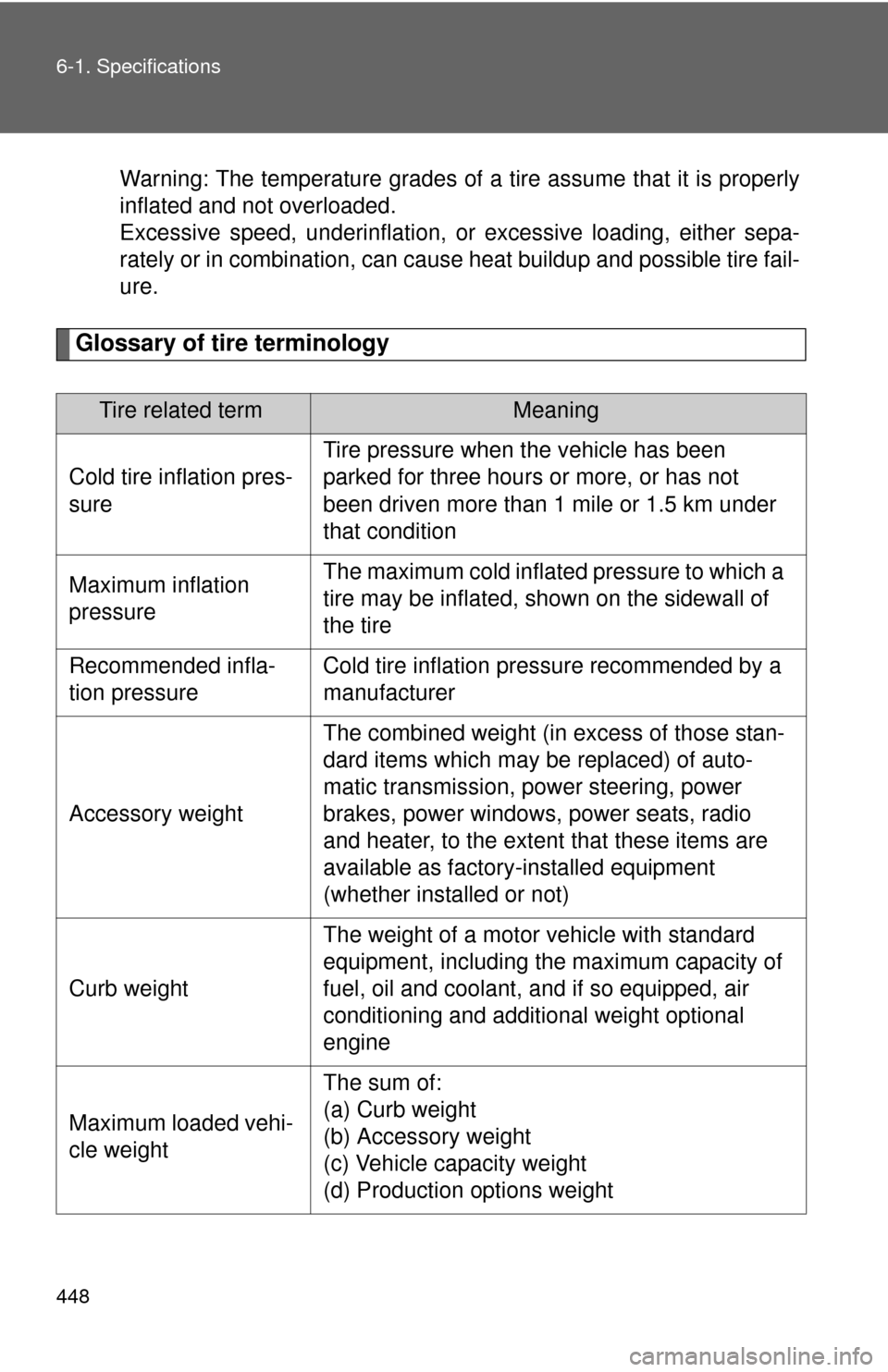Page 400 of 476
400
5-2. Steps to take in an emergency
If you have a flat tire
Remove the flat tire and replace it with the spare provided.
■Before jacking up the vehicle
●Stop the vehicle on a hard, flat surface.
● Set the parking brake.
● Shift the shift lever to P (automatic transmission) or R (manual
transmission).
● Stop the engine.
● Turn on the emergency flashers.
■ Location of the spare tire, jack and tools
Vehicles with a compact spare tire
Transport eyelet
(if equipped)
Spare tireJack
Wheel nut
wrench
Jack handle
Page 413 of 476
5
When trouble arises
413
5-2. Steps to take in an emergency
If the shift lever cannot be shifted from P (automatic transmission)
If the shift lever cannot be shifted with your foot on the brake, there
may be a problem with the shift lock system (a system to prevent
accidental operation of the shift lever). Have the vehicle inspected by
your Toyota dealer.
The following steps may be used as an emergency measure to
ensure that the shift lever can be shifted.
Set the parking brake.
Vehicles with smart key system: Turn the “ENGINE START
STOP” switch to the ACCESSORY mode.
Vehicles without smart key system: Turn the engine switch
to the “ACC” position.
Depress the brake pedal.
Pry the cover up with a flat-
head screwdriver or equiva-
lent.
Press the shift lock override
button.
The shift lever can be shifted
while the button is pressed.
STEP1
STEP2
STEP3
STEP4
STEP5
Page 424 of 476
424
5-2. Steps to take in an emergency
If the vehicle becomes stuck
■Emergency hooks (if equipped)
Carry out the following procedures if the tires spin or the vehicle
becomes stuck in mud, dirt, or snow.
Stop the engine. Set the parking brake and put the shift
lever in P (automatic transmission) or N (manual transmis-
sion).
Remove the mud, snow, or sand from around the stuck tire.
Place wood, stones or some other material to help provide
traction under the tires.
Restart the engine.
Shift the shift lever to the D or R position (automatic trans-
mission) or 1 or R position (manual transmission) and care-
fully apply the accelerator to free the vehicle.STEP1
STEP2
STEP3
STEP4
STEP5
When your vehicle becomes stuck and
cannot move, the emergency hooks are
used for another vehicle to pull your vehi-
cle out in an emergency.
Your vehicle is not designed to tow
another vehicle.
Page 425 of 476
5
When trouble arises
425
5-2. Steps to take in an emergency
CAUTION
■
When attempting to free a stuck vehicle
If you choose to rock the vehicle back and forth to free it, make sure the sur-
rounding area is clear, to avoid striking other vehicles, objects or persons.
The vehicle may also lunge forward or lunge back suddenly as it becomes
free. Use extreme caution.
■ When shifting the shift lever
For vehicles with an automatic transmission, be careful not to shift the shift
lever with the accelerator pedal depressed.
This may lead to unexpected rapid acceleration of the vehicle that may
cause an accident and result in death or serious injury.
NOTICE
■To avoid damaging the transmission and other components
●Avoid spinning the wheels and do not rev the engine.
● If the vehicle remains stuck after trying these procedures, the vehicle may
require towing to be freed.
Page 435 of 476

435
6-1. Specifications
6
Vehicle specifications
Clutch
Brakes
*1: Minimum pedal clearance when depressed with a force of 112 lbf (500 N,
51 kgf) while the engine is running
*2: Parking brake lever travel when pulled up with a force of 44 lbf (200 N, 20kgf)
*3: Parking brake pedal travel when depress ed with a force of 67 lbf (300 N, 31
kgf).
NOTICE
■ Automatic transmission fluid type
Using automatic transmission fluid other than “Toyota Genuine ATF WS”
may cause deterioration in shift quality, locking up of your transmission
accompanied by vibration, and ultimately damage the transmission of your
vehicle.
Pedal free play 0.2 0.6 in. (5 15 mm)
Fluid type SAE J1703 or FMVSS No.116 DOT 3
Pedal clearance*1
Automatic transmission
2.4 in. (61 mm)
Manual transmission
2.5 in. (63 mm)
Pedal free play 0.04 0.24 in. (1 6 mm)
Brake pad wear limit 0.04 in. (1.0 mm)
Parking brake lever travel*27 9 clicks
Parking brake pedal travel*37 10 clicks
Fluid type SAE J1703 or FMVSS No.116 DOT 3
Page 436 of 476
436 6-1. Specifications
Steering
Tires and wheels3.5 L V6 (2GR-FE) engine with 16-inch tires
Free play Less than 1.2 in. (30 mm)
Power steering fluid type Automatic transmission fluid DEXRON® II
or III
Tire size P215/60R16 94V,
T155/70D17 110M
Tire inflation pressure
(Recommended cold tire
inflation pressure)Driving under normal conditions
Front: 30 psi (210 kPa, 2.1 kgf/cm
2 or
bar)*
Rear: 30 psi (210 kPa, 2.1 kgf/cm
2 or
bar)*
Spare: Full-size spare tire
30 psi (210 kPa, 2.1 kgf/cm or bar)
Compact spare tire
60 psi (420 kPa, 4.2 kgf/cm or bar)
*: When driving at high speeds above 100 mph (160 km/h), in countries
where such speeds are permitted by
law, add 5 psi (30 kPa, 0.3 kgf/cm
2 or
bar) to the front tires and rear tires.
Never exceed the maximum cold tire
inflation pressure indicated on the tire
sidewall.
Wheel size 16
6 1/2 J or 16 6 1/2 JJ,
17 4 T (compact spare)
Wheel nut torque 76 ft•lbf (103 N•m, 10.5 kgf•m)
Page 448 of 476

448 6-1. Specifications
Warning: The temperature grades of a tire assume that it is properly
inflated and not overloaded.
Excessive speed, underinflation, or excessive loading, either sepa-
rately or in combination, can cause heat buildup and possible tire fail-
ure.
Glossary of tire terminology
Tire related termMeaning
Cold tire inflation pres-
sure Tire pressure when the vehicle has been
parked for three hours or more, or has not
been driven more than 1 mile or 1.5 km under
that condition
Maximum inflation
pressure The maximum cold inflated
pressure to which a
tire may be inflated, s hown on the sidewall of
the tire
Recommended infla-
tion pressure Cold tire inflation pressure recommended by a
manufacturer
Accessory weight The combined weight (in excess of those stan-
dard items which may be replaced) of auto-
matic transmission, power steering, power
brakes, power windows, power seats, radio
and heater, to the extent that these items are
available as factory-installed equipment
(whether installed or not)
Curb weight The weight of a motor vehicle with standard
equipment, including the maximum capacity of
fuel, oil and coolant, and if so equipped, air
conditioning and additional weight optional
engine
Maximum loaded vehi-
cle weight The sum of:
(a) Curb weight
(b) Accessory weight
(c) Vehicle capacity weight
(d) Production options weight
Page 456 of 476
456 6-2. Customization
Door lock
(
P. 41)Unlocking using a key
Driver's door
unlocked in one step, all doors
unlocked in two steps All doors
unlocked in one step.
Speed-detecting auto-
matic door lock function Off On
Opening driver's door
unlocks all doors Off On
Shifting gears to P
unlocks all doors. (auto-
matic transmission) On Off
Shifting gears to posi-
tion other than P locks
all doors. (automatic
transmission) On Off
Automatic
light control
system
(
P. 152) Light sensor sensitivity Level 3 Level 1 to 5
Time elapsed before
headlights automati-
cally turn off after doors
are closed
30 seconds0 seconds
60 seconds
90 seconds
Lights
(
P. 152) Daytime running light
system (U.S.A. only)
On Off
ItemFunctionDefault settingCustomized
setting